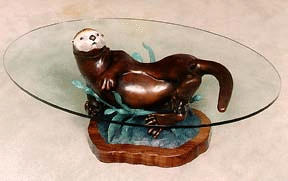Roy Peratrovich’s home resembles a nature preserve.
Otters twist through seaweed; bears loll in the sun; eagles perch on branches and killer whales leap – all worked in clay by the artist and then cast in bronze.
The animals that are the sculptures’ subject matter are the wildlife that Peratrovich, an Alaskan Tlingit native, grew up observing at close hand. Peratrovich combines some traditional native design with his own vision.
“I like to make stories to go with each piece,” Peratrovich said. “Some of them are based on traditional stories and some are my own.”
Peratrovich didn’t get the chance to invoke his childhood memories of Alaska in art until he retired, however.
In 1962, Peratrovich earned a degree from the University of Washington to become the first Alaskan native to become a civil engineer. Peratrovich founded his own engineering firm, Peratrovich, Nottingham and Drage, Inc.
“No one I knew even knew what an engineer did,” Peratrovich said. ‘They would say, ‘Here comes the engineer.’”
Peratrovich’s work ethic and drive were helpful tools when it came to learning to sculpt. In the three years since his retirement, he has covered a lot of ground.
Peratrovich swiftly discarded the awkwardness of early pieces – in which he might render every hair on the head of a subject rather than consider overall form – and emerged as an artist who could render the subtle torsion of the otter’s form, as he does in the beautiful “Sea Otter-Medviedki” that shows an otter sleeping in seaweed.
In that piece, form is handled with self-confidence that an artist may take decades to find.
Peratrovich manipulates the clay medium with an unerring touch, and his understanding of the potential of materials – both structural and aesthetic – is aided by the years of engineering.
“I designed bridges,” Peratrovich said. “I have a structural background.”
The intimacy of Peratrovich’s pieces may stem from the intimacy of the creative process.
Peratrovich ignores the conventional wisdom that prescribes building a piece built on an armature fixed in place, in favor of holding the clay in his hands as he works on it, cradling the emerging work as he might the animal.
Peratrovich is also successful in marrying Native tradition with Western idiom – a combination that might appear disjunctive in less skillful hands
Peratrovich leaves actual bronze casting to the Lalabo Foundry in Kalispell, Montana.
“It would take me years to learn to cast,” Peratrovich said, “and it would be just technical. I do work with them; I sit beside them through the process.”
Although Peratrovich concentrates on rendering animal forms, a bronze bust he crafted is on permanent display in the Alaskan legislature.
The subject is Peratrovich’s mother, Elizabeth Peratrovich.
“You can’t go to the legislature and the government without walking by it,” Peratrovich said.
For her work getting the first anti-discrimination legislation protecting the civil rights of Alaskan Natives passed (1945), Feb. 16 was declared “Elizabeth Peratrovich Day” in 1989.
Peratrovich’s latest work, on display at the Northwest Flower and Garden Show in Seattle this week – a life-scale otter “swimming” under the glass surface that is also a coffee table – pushes the boundaries for this artist.
“You’re not considered a ‘real artist’ by other artists until you can work big,” Peratrovich said, “so I decided to try it.”
Peratrovich says that the work’s title “Ottermatic Cruise Control” is derived from his observation of the otters’ habits.
“The seas otter twists his body in strands of kelp to keep from drifting while he sleeps – this is his ‘cruise control,’” Peratrovich said. “I used to see these kinds of things – they are close to me. ”



